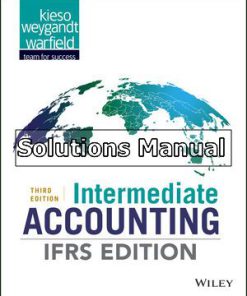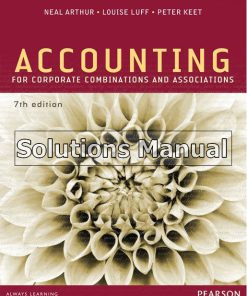Intermediate Accounting 17th Edition Kieso Solutions Manual
$26.50$50.00 (-47%)
Intermediate Accounting 17th Edition Kieso Solutions Manual.
You may also like
Instant download Intermediate Accounting 17th Edition Kieso Solutions Manual pdf docx epub after payment.

Product details:
- ISBN-10 : 1119503663
- ISBN-13 : 978-1119503668
- Author:
Intermediate Accounting, 17th Edition is written by industry thought leaders, Kieso, Weygandt, and Warfield and is developed around one simple proposition: create great accountants. Upholding industry standards, this edition incorporates new data analytics content and up-to-date coverage of leases, revenue recognition, financial instruments, and US GAAP & IFRS. While maintaining its reputation for accuracy, comprehensiveness, and accessibility, Intermediate Accounting drives results by helping students build professional competencies through reliable problem material.
Table of contents:
1 Financial Accounting and Accounting Standards 1-1
Exciting Times 1-2
Financial Reporting Environment 1-3
Parties Involved in Standard-Setting 1-7
Generally Accepted Accounting Principles 1-12
Major Challenges in Financial Reporting 1-14
FAS B Codification and Exercises 1-28
IFRS Insights 1-28
2 Conceptual Framework for Financial Reporting 2-1
What is It? 2-1
Conceptual Framework 2-3
Fundamental Concepts 2-6
Assumptions 2-14
Measurement, Recognition, and Disclosure Concepts 2-16
FAS B Codification and Exercises 2-37
IFRS Insights 2-38
3 The Accounting Information System 3-1
Needed: A Reliable Information System 3-2
Accounting Information System 3-3
Record and Summarize Basic Transactions 3-9
Adjusting Entries 3-19
Preparing Financial Statements 3-30
Financial Statements for a Merchandising Company 3-35
Appendix 3A: Cash-Basis Accounting versus Accrual-Basis Accounting 3-38
Conversion from Cash Basis to Accrual Basis 3-40
Theoretical Weaknesses of the Cash Basis 3-43
Appendix 3B: Using Reversing Entries 3-43
Illustration of Reversing Entries—Accruals 3-43
Illustration of Reversing Entries—Deferrals 3-44
Summary of Reversing Entries 3-45
Appendix 3C: Using a Worksheet: The Accounting Cycle Revisited 3-46
Worksheet Columns 3-46
Adjustments Entered on the Worksheet 3-48
Preparing Financial Statements from a Worksheet 3-49
Analytics in Action 3-73
FAS B Codification and Exercises 3-73
IFRS Insights 3-73
4 Income Statement and Related Information 4-1
Financial Statements Are Changing 4-2
Income Statement 4-3
Content and Format of the Income Statement 4-6
Reporting Various Income Items 4-11
Accounting Changes and Errors 4-18
Related Stockholders’ Equity Statements 4-21
FAS B Codification and Exercises 4-42
IFRS Insights 4-43
5 Balance Sheet and Statement of Cash Flows 5-1
Hey, It Doesn’t Balance! 5-1
Balance Sheet 5-3
Preparation of the Balance Sheet 5-15
Statement of Cash Flows 5-16
Additional Information 5-24
Appendix 5A: Ratio Analysis—A Reference 5-30
Using Ratios to Analyze Performance 5-30
Analytics in Action 5-57
FAS B Codification and Exercises 5-58
IFRS Insights 5-58
6 Accounting and the Time Value of Money 6-1
How Do I Measure That? 6-1
Basic Time Value Concepts 6-3
Single-Sum Problems 6-8
Annuities (Future Value) 6-13
Annuities (Present Value) 6-20
Other Time Value of Money Issues 6-24
Analytics in Action 6-45
FAS B Codification and Exercises 6-45
7 Cash and Receivables 7-1
Is Your Cash Trapped? 7-1
Cash 7-3
Receivables 7-7
Valuation of Accounts Receivable 7-11
Notes Receivable 7-17
Other Issues 7-21
Appendix 7A: Cash Controls 7-30
Using Bank Accounts 7-31
The Imprest Petty Cash System 7-31
Physical Protection of Cash Balances 7-32
Reconciliation of Bank Balances 7-33
Appendix 7B: Collectibility Assessment Based on Expected Cash Flows 7-35
Measurement of Collectibility 7-36
Analytics in Action 7-62
FAS B Codification and Exercises 7-62
IFRS Insights 7-63
8 Valuation of Inventories: A Cost-Basis Approach 8-1
To Switch or Not to Switch 8-2
Inventory Issues 8-3
Goods and Costs Included in Inventory 8-7
Which Cost Flow Assumption to Adopt? 8-12
Special Issues Related to LIFO 8-16
Effect of Inventory Errors 8-29
FAS B Codification and Exercises 8-56
9 Inventories: Additional Valuation Issues 9-1
Not What It Seems to Be 9-2
Lower-of-Cost-or-Net Realizable Value 9-3
Lower-of-Cost-or-Market 9-7
Other Valuation Approaches 9-11
The Gross Profit Method of Estimating Inventory 9-15
Retail Inventory Method 9-18
Presentation and Analysis 9-24
Appendix 9A: LIFO Retail Methods 9-26
Stable Prices—LIFO Retail Method 9-26
Fluctuating Prices—Dollar-Value LIFO Retail Method 9-27
Subsequent Adjustments Under Dollar-Value LIFO Retail 9-29
Changing from Conventional Retail to LIFO 9-29
Analytics in Action 9-53
FAS B Codification and Exercises 9-53
IFRS Insights 9-54
10 Acquisition and Disposition of Property, Plant, and Equipment 10-1
Watch Your Spending 10-2
Property, Plant, and Equipment 10-3
Interest Costs During Construction 10-6
Valuation of Property, Plant, and Equipment 10-12
Costs Subsequent to Acquisition 10-20
Disposition of Property, Plant, and Equipment 10-24
Appendix 10A: Accounting for Contributions 10-25
Conditional Contribution 10-26
Unconditional Contribution 10-27
Exchange Transactions 10-27
FAS B Codification and Exercises 10-52
11 Depreciation, Impairments, and Depletion 11-1
Here Come the Write-Offs 11-2
Depreciation—A Method of Cost Allocation 11-3
Special Depreciation Methods and Other Issues 11-9
Impairments 11-14
Depletion 11-17
Presentation and Analysis 11-22
Appendix 11A: Income Tax Depreciation 11-25
Modified Accelerated Cost Recovery System 11-25
Optional Straight-Line Method 11-27
Tax versus Book Depreciation 11-27
Analytics in Action 11-49
FAS B Codification and Exercises 11-49
IFRS Insights 11-50
12 Intangible Assets 12-1
Is This Sustainable? 12-1
Intangible Asset Issues 12-3
Types of Intangible Assets 12-6
Impairment and Presentation of Intangible Assets 12-14
Research and Development Costs 12-19
Analytics in Action 12-42
FAS B Codification and Exercises 12-42
IFRS Insights 12-43
13 Current Liabilities and Contingencies 13-1
Now You See It, Now You Don’t 13-2
Current Liabilities 13-3
Short-Term Obligations Expected to Be Refinanced 13-15
Contingencies 13-17
Presentation and Analysis 13-28
Analytics in Action 13-53
FAS B Codification and Exercises 13-53
IFRS Insights 13-54
14 Long-Term Liabilities 14-1
Going Long 14-1
Bonds Payable 14-3
Extinguishment of Debt 14-13
Long-Term Notes Payable 14-14
Reporting and Analyzing Liabilities 14-20
Appendix 14A: Troubled-Debt Restructuring 14-26
Settlement of Debt 14-27
Modification of Terms 14-28
Concluding Remarks 14-33
FAS B Codification and Exercises 14-51
IFRS Insights 14-52
Appendix A Private Company Accounting A-1
The Private Company Council (PCC) A-1
Private Company Alternatives for Intangible Assets and Goodwill A-2
Summary A-6
Appendix B Specimen Financial Statements: The Procter & Gamble Company B-1
Appendix C Specimen Financial Statements: The Coca-Cola Company C-1
Appendix D Specimen Financial Statements: PepsiCo, Inc. D-1
Appendix E Specimen Financial Statements: Marks and Spencer plc E-1
Index I-1
People also search:
Intermediate Accounting 17th Edition
Intermediate Accounting 17th Edition pdf
Intermediate Accounting
what is intermediate accounting
what is intermediate accounting about













Reviews
There are no reviews yet.